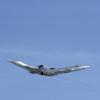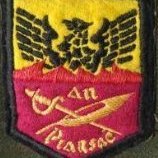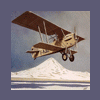-
Posts
2,004 -
Joined
-
Last visited
About rossm

- Birthday 01/11/1956
Contact Methods
-
Website URL
http://www.hrmtech.com/SIG/index.asp
-
ICQ
0
Profile Information
-
Gender
Male
-
Location
Delightful Devon
-
Interests
RAF & civil aircraft in Devon/Cornwall/Norfolk
Recent Profile Visitors
6,191 profile views
rossm's Achievements

Very Obsessed Member (5/9)
1.2k
Reputation
-
More looking at the Air Britain book and the Putnam volume by Don Brown (long term Assistant to FG Miles) don't show any reference to larger wings for G-ADWT. It started life as an M.2W but was probably modified to M.2Y standard befoe the spinning trials. The difference seems to have been a horn balanced rudder and stronger tailplane spar. There is a photo of G-AENT which was an M.2Y with a horn balanced rudder in the AB book. As the cure for the spinning issue was all done at the tail with strakes, raised tailplane and, finally, a larger rudder on the M.14A version of the Magister I'm sceptical about the larger wings, despite the wording of the report on the G-ADWT trials. The February 1937 report on the G-AENT crash (reproduced in the AB book) mentions further tests by Miles and says "In general the Firm are satisfied, as a result of these further tests, that this type of aircraft will come out of the spin under any circumstances tried". It seems unlikely that "the Firm" would create a new set of wings if they hadn't seen a problem in their trials. There is a hint in the detailed history in the AB book that some modification was done to ADWT in early 1937 as the CofA was renewed but it is assumed this was the work done to bring it to M.2Y standard. It does give room for speculation about other changes but I don't know where you would find any evidence.
-
rossm started following Miles Hawk/Hawk Trainer/Magister Wings.
-
There is nothing in the Air Britain Miles Aircraft - The Early Years book by Peter Amos to support G-ADWT having different wings from other M.2W or M.2Y aircraft. Compared with the earlier M.2F the span increased from 33ft to 34ft but that was standard for the version. The Magister span was 33ft 10in. I've only looked into it for this reply but I think great care needs to be taken with all the different M.2 versions as there were many.
-
rossm started following Aircraft Cold War
-
rossm started following B-24 Liberator. , Looking to confirm colour scheme of a 600 SQ Beaufighter VIf. , Liberator I and II differences and 4 others
-

Looking to confirm colour scheme of a 600 SQ Beaufighter VIf.
rossm replied to Adriano Panetta's topic in Aircraft WWII
There is a photo of V8388 coded 6 Y in both Red Kite Beaufighter Squadrons and Wingleader Photo Archive 10. It appears to be in standard nightfighter overall Medium Sea Grey with Dark Green disruptive pattern on the upper surfaces. What colour the code letters are is debatable but they "should" be Dull Red. It has AI Mk.IV rather than the thimble radome. -
You would think so but they had to make the rear fuselage deeper so were making structural changes anyway and the numbers don't show any increase in length other than the nose extension. Putting a heavy turret even further aft would have upset the CofG so not desirable. The puzzle to me is that no other sources mention it. I wonder if correcting the CofG was the reason for the nose extension???
-
James Oughton's book on the Liberator in RAF and Commonwealth Service (Air Britain) gives the Liberator I length as 63ft 8.5in and the Liberator II as 66ft 0in. The Aerodata mongraph says the nose extension was 31in. Given the tail turret sticks out where the Liberator I gun position did not it seems the tailplane must have moved forward - but neither of these references nor the Crowood book on the type mention that happening.
-

Avro Anson- entering service with 48 (GR) Squadron March 1936
rossm replied to gingerbob's topic in Aircraft Interwar
No.48 was not a GR squadron until September 1938, according to the Air Britain K File it "reformed on 25th Nov 1935 but was not an operational unit as it formed the basis of the School of Air Navigation. Ansons began to arrive in quantitiy in March 1936 and the squadron grew to have an establishment of no less than 80 during 1936. It continued its training role until September 1938 nwhen it was reduced to more normal size and became an operational GR squadron." There is a photo of Anson K6164 of 48 Squadron with just a single letter code of X. It left 48 Sqdn in January 1938 and another of K6323 with single letter Y of 48 Sqdn which left it in March 1938. I'll stick my neck out and suggest the 48 squdron code was not applied as the Munich camouflage came in about the time the squadron moved to an operational role. There are other photos in the Warpaint, none with a 48 code, just single letters. I'll check the Air Britain Anson File when I can get SWMBO to move her clutter from in front of the shelf it's on 😊 A recently published reference I don't have is Avro Anson Mark I in Worldwide Service - Wingleader Photo Archive 25 -
Also a 10 page article in Air Enthusiast 10 (July-Sept 1979). I can scan it, just PM me an email address...
-
There is an 11 page article in Air Enthusiast no6 including individual aircraft summary histories. PM me if you would like a scan.
- 16 replies
-
- 3
-

-

-
- Curtiss Condor
- Golden Age
-
(and 1 more)
Tagged with:
-
The Xtradecal sheet for postwar serials can also be used for many wartime aircraft https://www.hannants.co.uk/product/X72157 The code sheet Pat refers to is https://www.hannants.co.uk/product/X72145 Kits World also offer sheets combining 8" serials with 28" codes (72154) or with 24" codes (72155) again available from Hannants - these would be a solution if you chose a squadron with that size code (see below) The "Camouflage and Markings" booklet for the Spitfire can be found at https://boxartden.com/reference/gallery/index.php/Camouflage-Markings/Supermarine-Spitfire It needs careful reading, especiall for code letter sizes which seem to have varied on early Spitfires as the regulation stated 48" high or smaller if room was not available, As 48" was too big for a Spitfire squadrons were left to make their own interpretation so 24", 28", 30" and 36" are possible.
-
There are books where you can find serial number and code letter combinations for many squadrons e.g. Fighter Squadrons of the RAF by JDR Rawlings but sadly out of print at the moment. The best place is the squadron Operations Record Books at the National archives which are available online and free if you sign up for an account which is also free. Not all units recorded both but many did and that way you guarantee the aircraft you choose were with the squadron on the same day. For colour scheme and markings the "Camouflage and Markings" series is a good start and can be found online at boxartden. I don't have the Spitfire volumes but I think the Wingleader Photo Archive series is a good source aimed at modellers.
-
So the colour scheme is probably not representative of Chinese AF aircraft.
- 11 replies
-
- 1
-

-
- MiG 19
- Shenyang J-6
-
(and 1 more)
Tagged with:
-
I'm not entirely convinced by the MiG-21 intake cone fitted to it!
- 11 replies
-
- 2
-

-

-
- MiG 19
- Shenyang J-6
-
(and 1 more)
Tagged with:
-
Nothing in the Air Britain book by Oughton either.
-
Not one I have either but the Wingleader book is by the same author, contains a lot of detail and is both cheaper and available although it may not have room for all the information in the JaPo book. No photos of the desired aircraft in it though.
-
The new Wingleader photo archive book confirms AM923 had the same radar and cannon fitted as AM925 but no photos of the latter.










